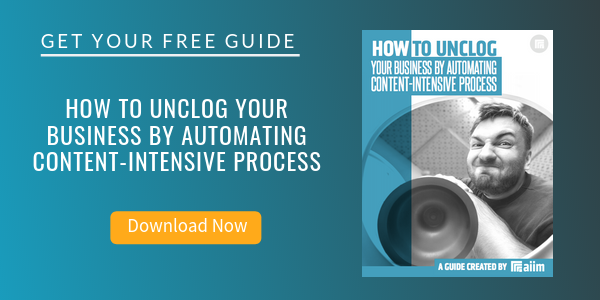
12 Things You Can Do NOW to Use BPM to Drive Digital Transformation
Process Automation | Business Process Management (BPM)
Process improvement and workflow are not new; in fact, they have been around since the late 1980s. Yes, they have evolved and continue to do so, but as was true of ECM, Business Process Management -- once seen as a nice to have -- is now considered a critical part of business operations.
Process improvement and automation using BPM as the framework is an essential part of the Digital Transformation of businesses. The more paper is eliminated from processes and digitally born information is created, the greater the dependence upon and need for efficient, effective, and secure digital workflows. When assessing process improvement and automation opportunities, including the identification of and ways various information sets are integrated with the process and remember to look at the end-to-end process rather than just the departmental workflow. What gets changed in the department could have a negative impact on other departments feeding this process or that this process feeds.
Our new latest research on Process Improvement and Automation is now available!
12 Key Process Improvement and Automation Recommendations
-
Begin with existing process maps if they exist and if they do not; create at minimum, high level maps to document the steps in the process.
-
Identify areas of opportunity for process improvement. Look for bottlenecks in the process and ways these bottlenecks can be eliminated. Perhaps use of parallel processing would be the approach.
-
Improve the existing process before introducing automation or extending the automation capabilities you have in place. Automating an inherently bad process will not resolve the underlying issues.
-
Uncover the real business problem you are trying to solve. When you are told that the issue is slow processing times or too many exceptions, look deeper into the root cause. Ask the question of why there are too many exceptions.
-
Assess how paper can be eliminated from the process. If the reason for paper is one of acquiring signatures, explore how e-signature can be incorporated to enhance the process, and eliminate the paper.
-
Take time to design the process. The best question to ask is why things are done the way they are and then explore how it could be different.
-
Take inventory of your current BPM capabilities, using this as the foundation of reference when developing a set of requirements. In this way, you can maximize your current investment and only purchase those technologies that are missing.
-
Document the business requirements first. “I need capture capabilities of 500 pages-per-minute,” is not a business requirement. The business requirement is “to process 10,000 applications per day, in 50 locations around the globe.”
-
Build your functional requirement based on the business requirements. Map the current process of capturing applications from each location, including volumes and all activities to bring this information into your systems.
-
Develop technical requirements based on the functional requirements and map these against your current technology sets. In other words, do a gap analysis to determine what is missing then seek to purchase the missing elements.
-
Consider how cloud and mobile device use, along with mobile apps, can help address your current needs and support remote workers and stakeholders of your processes. At the same time, assess how these would be synchronized across the enterprise and the line-of-business applications. Remember that BPM can serve as the integrating mechanism.
-
Establish a continuous improvement program that will periodically review and refine those changes you make now. BPM is not a one-stop project; it should be a cross-functional team sport that is ongoing across the enterprise.
About Bob Larrivee
Bob is the President and Founder of Bob Larrivee Consultancy. An internationally recognized Subject Matter Expert and thought leader with over thirty years of experience in the fields of information and process management, Bob is an avid techie with a focus on the application of advanced technologies to enhance business operations.



